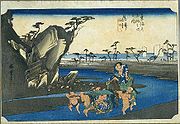
Okitsu-juku
Encyclopedia

53 Stations of the Tokaido
The are the rest areas along the Tōkaidō, which was a coastal route that ran from Nihonbashi in Edo to Sanjō Ōhashi in Kyoto.-Stations of the Tōkaidō:...
of the Tōkaidō
Tokaido (road)
The ' was the most important of the Five Routes of the Edo period, connecting Edo to Kyoto in Japan. Unlike the inland and less heavily travelled Nakasendō, the Tōkaidō travelled along the sea coast of eastern Honshū, hence the route's name....
. It is located in what is now part of the Shimizu-ku
Shimizu-ku, Shizuoka
is one of three wards of the city of Shizuoka, in Shizuoka Prefecture, Japan, located in the eastern part of the city.-Geography:Shimizu is located on the coast of Suruga Bay of the Pacific Ocean and covers a wide area from a coastal plain to the hills...
area of Shizuoka
Shizuoka, Shizuoka
is the capital city of Shizuoka Prefecture, Japan, and the prefecture's second-largest city in terms of both population and area. It became one of Japan's 19 "designated cities" in 2005.-Geography:...
, Shizuoka Prefecture
Shizuoka Prefecture
is a prefecture of Japan located in the Chūbu region on Honshu island. The capital is the city of Shizuoka.- History :Shizuoka prefecture was formed from the former Tōtōmi, Suruga and Izu provinces.The area was the home of the first Tokugawa Shogun...
, Japan
Japan
Japan is an island nation in East Asia. Located in the Pacific Ocean, it lies to the east of the Sea of Japan, China, North Korea, South Korea and Russia, stretching from the Sea of Okhotsk in the north to the East China Sea and Taiwan in the south...
.
History
Okitsu-juku was established in 1601, just before the beginning of the Edo periodEdo period
The , or , is a division of Japanese history which was ruled by the shoguns of the Tokugawa family, running from 1603 to 1868. The political entity of this period was the Tokugawa shogunate....
. At its peak, there were approximately 316 buildings and 1,668 people. Among the buildings were two honjin
Honjin
thumb|250px|The honjin at [[Inaba Kaidō]]'s [[Ōhara-shuku]]. is the Japanese word for an inn for government officials, generally located in post stations during the later part of the Edo period.-Evolution of Honjin:...
, two sub-honjin and 34 hatago
Hatago
were Edo period lodgings for travelers at shukuba along the national highways, including the Edo Five Routes and the subroutes. In addition to a place to rest, hatago also offered meals and other foods to the travelers...
. It was a little over 11 kilometers from the preceding post station
Shukuba
were post stations during the Edo period in Japan, generally located on one of the Edo Five Routes or one of its sub-routes. They were also called shukueki . These post stations were places where travelers could rest on their journey around the nation...
, Yui-shuku
Yui-shuku
was the sixteenth of the fifty-three stations of the Tōkaidō. It is located in the Shimizu-ku area of Shizuoka, Shizuoka Prefecture, Japan. It is one of four former post stations located in Shimizu-ku.-Area information:...
.
The classic ukiyoe print by Ando Hiroshige (Hoeido edition) from 1831-1834 depicts two sumo
Sumo
is a competitive full-contact sport where a wrestler attempts to force another wrestler out of a circular ring or to touch the ground with anything other than the soles of the feet. The sport originated in Japan, the only country where it is practiced professionally...
wrestlers being carried across the Okitsu River, one on a packhorse and the other in a kago
Kago
A ' is a Japanese type of litter, suspended by a single crossbeam, carried by two men, usually used to transport one person at a time. The front and back of the kago is always covered; the sides can be left open, or encased by folding screens. This should not be confused with the more elaborate...
.
Further reading
- Carey, Patrick. Rediscovering the Old Tokaido:In the Footsteps of Hiroshige. Global Books UK (2000). ISBN 1901903109
- Chiba, Reiko. Hiroshige's Tokaido in Prints and Poetry. Tuttle. (1982) ISBN 0804802467
- Taganau, Jilly. The Tokaido Road: Travelling and Representation in Edo and Meiji Japan. RoutledgeCurzon (2004). ISBN 0415310911

